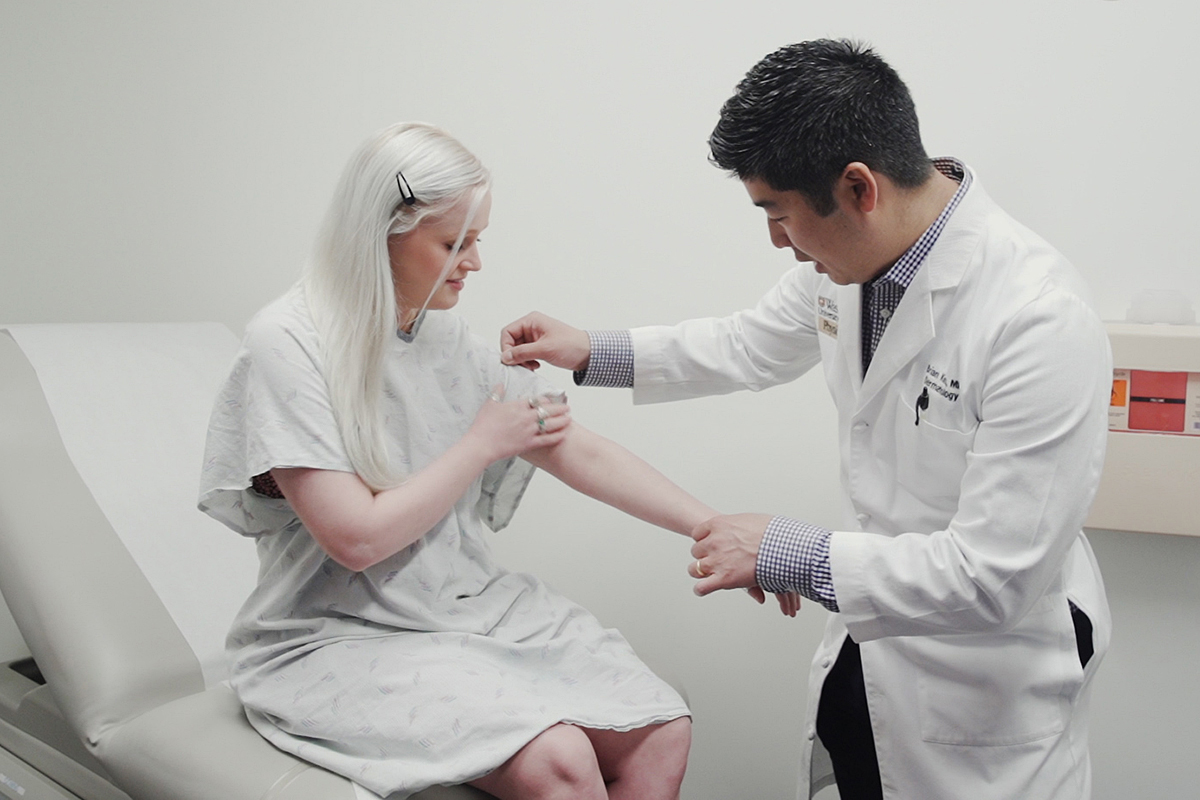Spring allergens such as pollen, mold spores and other airborne particles not only trigger nasal allergies, but also can have a profound effect on a variety of allergic conditions including asthma and eczema
Tag: Eczema
New study reveals that some children with common form of eczema should also be tested for allergic reactions
Eczema, which is a group of medical conditions that causes inflamed, irritated, and often itchy skin, affects millions of people worldwide. A new article published in the reveals that children diagnosed with a type of eczema called atopic dermatitis — which they usually develop by 5 years of age — may also need to be tested for a second type of eczema called allergic contact dermatitis, which has similar symptoms and can be triggered by a range of substances that cause an allergic reaction.
CHOP Researchers Validate Pediatric “Allergic March” in Largest National Study of its Kind
In the largest study of its kind, researchers from Children’s Hospital of Philadelphia (CHOP) used electronic health record (EHR) data from more than 200,000 pediatric patients to describe patterns of pediatric allergies across the United States, validating a population-level pattern of allergy development known as the “allergic march,” in which allergies first present as eczema, followed by food allergies, asthma, and environmental allergies. The researchers also found that a rare food allergy called eosinophilic esophagitis (EoE), which has historically been considered a disease affecting primarily White males, is more common among non-White patients than previously reported.
Treatment Options for Pregnant Women Living with Eczema and Psoriasis
Psoriasis and eczema affect men and women differently, with women needing to take extra precautions when considering treatments if they’re planning for pregnancy.
Mount Sinai Researchers Awarded $12 Million NIH Grant to Create a Center to Unravel Novel Causes of Food Allergy and Atopic Dermatitis
Mount Sinai researchers have been awarded $12 million over five years by the National Institutes of Health to create a center to elucidate novel causes of, and contributing factors to, food allergies and atopic dermatitis. The Systems Biology of Early Atopy (SunBEAm) Analysis and Bioinformatics Center intends to develop a better understanding of allergy development. The center will apply systems biology to identify early-life markers of risk for food allergies and atopic dermatitis (also known as eczema), as well as biological pathways underlying these common conditions, through the profiling and analysis of longitudinal multi-omics data from a multi-center pre-birth cohort of 2,500 children.
How to treat eczema at home
ROSEMONT, Ill. (October 27, 2022) — Eczema, or atopic dermatitis, is a common skin condition affecting 1 in 10 Americans. Patients with eczema often experience itchy, dry, raw, and sensitive patches of skin, which greatly impacts their quality of life. As we wrap up Eczema Awareness Month, board-certified dermatologists provide easy steps you can take at home to ease your symptoms.
How to tell the difference between dry hands and hand eczema
Hand eczema is one of the most common forms of eczema, causing dry, itchy, and irritated skin affecting the whole hand, including the fingers. This skin condition can negatively impact a person’s quality of life because we use our hands often. In recognition of Eczema Awareness Month in October, board-certified dermatologists share information about the causes of hand eczema and how it can be treated to keep the condition from worsening.
The right moisturiser for children with eczema is the one that they like to use, study finds
The Best Emollients for Eczema trial has found that no one type of moisturiser is better than another. This study, the first in the world to directly compare different types of moisturisers, highlights the importance of patient education and choice when deciding which moisturisers to use for children with eczema. The results from the National Institute for Health and Care Research (NIHR) funded study are published in The Lancet Child and Adolescent Health and British Journal of General Practice today (24 May).
Gene For Sex Hormone Synthesis Could Play Key Role in Eczema
A study led by UT Southwestern dermatologists suggests that a common inflammatory skin condition may stem from poorly regulated sex hormones. The finding, published this week in PNAS, could offer an unexpected new target to fight this condition.
Oral Medication Shows Strong Promise for Moderate to Severe Atopic Dermatitis in Mount Sinai-led Study
An oral medication called upadacitinib yielded rapid and significant improvements in patients with moderate to severe atopic dermatitis (AD), also known as eczema, in phase 3 clinical trials, Mount Sinai researchers reported today in The Lancet online.
Last-Itch Effort: Fighting the Bacteria That Exacerbate Eczema with Bacteria
Researchers at UC San Diego School of Medicine use bacteriotherapy to improve symptoms of atopic dermatitis.

Research News Tip Sheet: Story Ideas from Johns Hopkins Medicine
During the COVID-19 pandemic, Johns Hopkins Medicine Media Relations is focused on disseminating current, accurate and useful information to the public via the media. As part of that effort, we are distributing our “COVID-19 Tip Sheet: Story Ideas from Johns Hopkins” every other Wednesday.

Acute itching in eczema patients linked to environmental allergens
New research from Washington University School of Medicine in St. Louis indicates that allergens in the environment often are to blame for episodes of acute itch in eczema patients, and that the itching often doesn’t respond to antihistamines because the itch signals are being carried to the brain along a previously unrecognized pathway that current drugs don’t target.
Study finds antibiotics before age 2 associated with childhood health issues
In a retrospective case study, Mayo Clinic researchers have found that antibiotics administered to children younger than 2 are associated with several ongoing illnesses or conditions, ranging from allergies to obesity. The findings appear in Mayo Clinic Proceedings.
Mount Sinai Researcher Identifies Single Gene Biomarker to Differentiate Between Atopic Dermatitis and Psoriasis Using Adhesive Tape Strips
Mount Sinai researchers have pinpointed a single gene biomarker, nitride oxide synthase 2 (NOS2) that can distinguish atopic dermatitis (AD) and psoriasis with 100 percent accuracy using adhesive tape strips, a non-invasive alternative to skin biopsy. The research will be published online today in the Journal of Allergy and Clinical Immunology.
Mount Sinai Researcher Receives NIH Award to Study Immune Responses of Patients With Inflammatory Skin Diseases in the Setting of COVID-19 Infection
The study will aim to understand whether systemic medications and biologics, such as dupilumab—a monoclonal antibody that binds to an inflammatory molecule, IL-4 receptor alfa, and inhibits the inflammatory response that leads to rashes and itching from atopic dermatitis/eczema—may have a positive or negative impact on COVID-19 responses in patients who have the disease.
Biomedical researchers get closer to why eczema happens
A new study from Binghamton University, State University of New York may help to peel back the layers of unhealthy skin — at least metaphorically speaking — and get closer to a cure.
Researchers Identify Mechanisms That Make Skin a Protective Barrier
Study Could Help Doctors Understand and Treat Common Conditions

Revving up immune system may help treat eczema
Studying eczema, researchers at Washington University School of Medicine in St. Louis have found that boosting the number of natural killer cells in the blood is a possible treatment strategy for the skin condition and also may help with related health problems, such as asthma.
NEWS ROUNDUP: BREAKING NEWS ON ORAL FOOD CHALLENGES
Two medically challenging cases being presented at the American College of Allergy, Asthma and Immunology (ACAAI) Annual Scientific Meeting contain new information on the benefits of oral food challenges when diagnosing food allergies.

Painless Tape Strips Used to Detect Molecular Changes in Skin of Children with Eczema
In a study using non-invasive tape strips in young children with eczema (or atopic dermatitis), researchers found many molecular signs of immune dysfunction and skin changes that relate to disease activity. These signs (or biomarkers) were present even before eczema was visible and can be used to track disease activity over time. With more research, these biomarkers also may help predict response to medicine and development of conditions associated with eczema, such as asthma, other allergies, infections and even attention deficit hyperactivity disorder (ADHD). Findings were published in JAMA Dermatology.